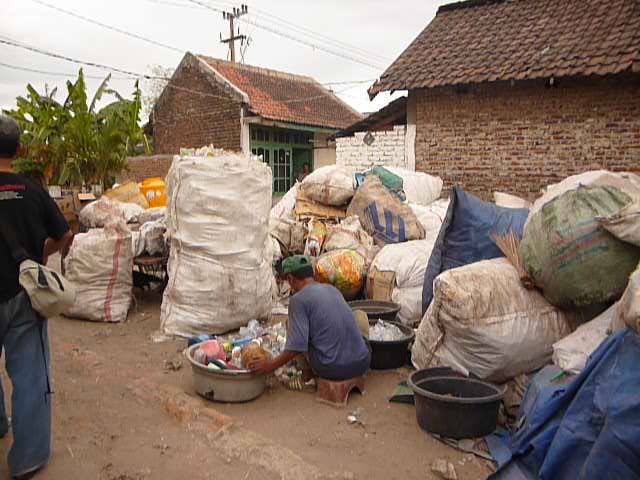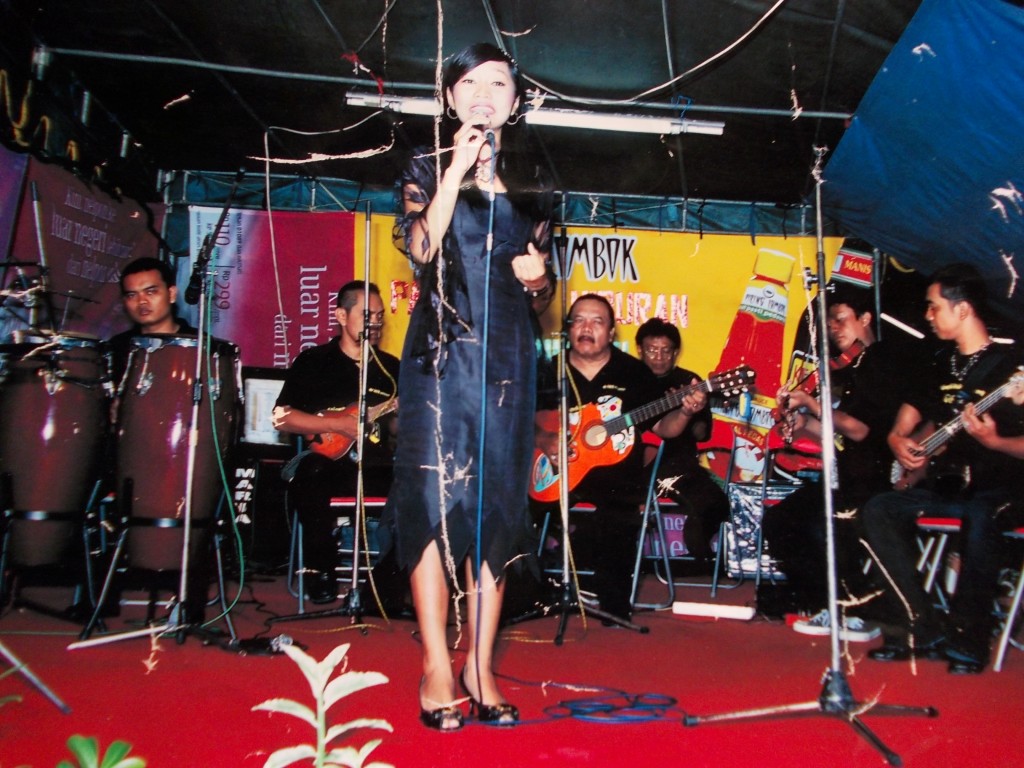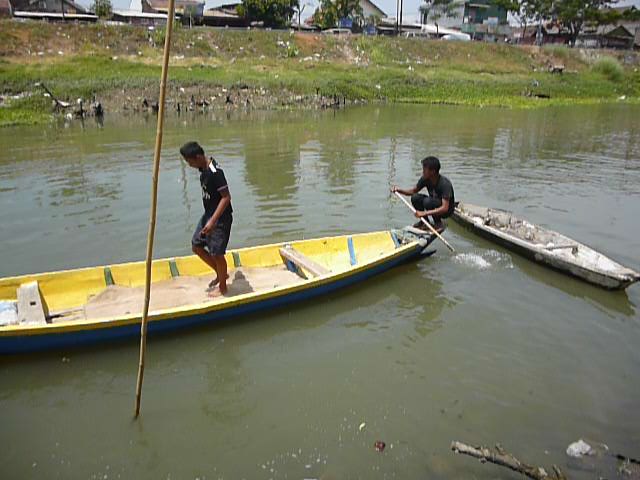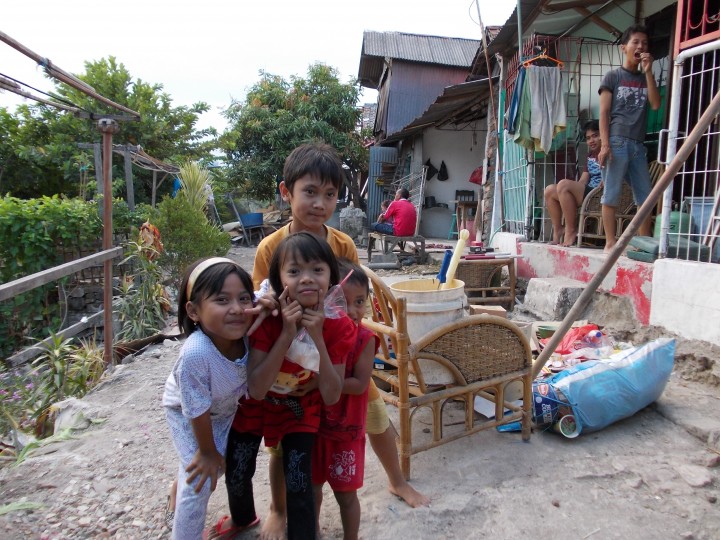
“The beauty of a riverbank village will charm you when you visit Bratang Tangkis,” said Mr. Gatot Subroto. What attracted visitors to this village when it began appearing in the 1950s?
The History of the Bratang Tangkis village, and the Assoication of Bratang Kali Villagers
Bratang Tangkis is located approximately 1.5 kilometers to the east of Water Gate on the north side of Jagir river in Wonokromo. Originally there were rows of thatched huts, banana trees, palm trees, bamboo and other shade trees. The huts that were then developed were semi-permanent homes, but they eventually became permanent homes.
Villagers then organized an association called PWSS (Paguyuban Warga Strenkali Surabaya, Association of Strenkali Residents in Surabaya) to fight for the legal ownership of the village land, as well as to promote participatory and self-reliant methods of organising their villages. They developed the concept of Jogo Kali (caring for the river) as a catalyst for environmental awareness as well as to develop the economy and culture.
Self-reliance and Collaboration in Facing Eviction
Through PWSS which was founded on May 31st 2002, villagers worked independently and collaboratively to defend Bratang Tangkis from several eviction attempts, either by the local government of Surabaya or by the East Javanese Provincial Government.
Finally, on October 5, 2007, the aspirations of the people were heard and legalized by the Council of East Java through the regional law (Peraturan Daerah) no. 9 2007 which contains various ideas from different stakeholders. Article 13 of the law mentions that limited settlements along the river are allowed with appropriate oversight. This is a “victory” for the Bratang Tangkis villagers and PWSS.
Riverbank homes

A program to build 70 sample houses in Bratang Tangkis was initiated in 2005, and construction began in 2008. Village houses that initially had their backs turned towards the river have now been turned to overlook the river. This change was followed up with the construction of a road 3-5 meters wide, at the expense of much of the existing housing. This new infrastructure indicates readiness and mutual support from residents willing to improve the look of the village. This is a fascinating phenomenon given that, nowadays, people in the city are rarely willing to sacrifice and work together for a shared purpose. In addition, the villagers, supported by Uplink and PWSS, created a collective fund to repair their own homes in 2002. With this program, people are brought together.
Higher education institutions have also had a hand in the village’s structuring and in building awareness of the community. The design of the village was inspired from a design contest held in the village of Strenkali, initiated by the Rujak Center for Urban Studies and PWSS in 2011. The contest involved seven renowned architects, including Early Han, Ridwan Kamil, Adi Purnomo, Eko Prawoto, Yu Sing, Avianti Armand, and Wiyoga Nurdiansyah. The winner, Wiyoga, proposed the concept of diversity within uniformity. Although the concept is not entirely implemented, it continues to be developed by the community with the construction of 70 new house designs using concrete materials and exposed bricks. They will color the banks of Surabaya River area all the way to Medokan Semampir.
Management of organic waste

There is a growing awareness of citizens to manage organic waste through the Takakura composting method. The Takakura method entails managing waste water with a septic tank, urban farming and planting greenery in front of the house. “In this way, we can really demonstrate to the government that we can make this area better, not just changing the way it looks. We need to change the way the whole town sees us,” commented Mr. Andreas Suhadi, former Secretary-General PWSS.
Initiatives in organic waste management, waste water and greenery planting, assisted by the Center for Urban Community Empowerment (Pusdakota) University of Surabaya have helped Bratang Tangkis win recognition within the country, through awards such as the 2005 Top 10 Green and Clean Kampung Competition Awards.
Collaboration with Pusdakota can reduce municipal solid waste and create the space for green businesses to emerge, such as “Rubbish Bank” and cetok-making, cetok’s being small shovels in Takakura composting. The cetok is known nationally as a successful use of waste plastic piping, making shovels of good and durable quality. It also is one of the more successful efforts of Jogo Kali.
From cetok to vehicle dynamo

A variety of labor-intensive small businesses have appeared, in addition to the cetok business. Among them are making vehicle dynamo businesses, foodstalls, laundry businesses, PlayStation rentals and more. This effort was initiated by the residents themselves. Once sufficiently developed, Ministry of Social Affairs began to provide assistance through KUBE (Joint Business Group) to improve the social welfare of the poor.
This assistance aims to develop the dynamics of social groups for the improvement of group relationships and the economic and social independence of these groups. There are two types of capital funding provided by KUBE: small business development funds and physical home improvement funds for homes that are no longer livable.
Larung and Jogo Kali
The ethos of the community, Jogo Kali, is also seen in the people swimming in the river carried out every year by the residents Bratang integrated with other resident . Larung is a symbol of the unity of the people, the maintenance of the river and gratitude to God. It is a presentation of the work of residents and meant to thank Kali Wonokromo for the good fortune afforded.
Larung shows the preservation of local culture as Ngremo, Nembang, Sajen convoy and others who are often abandoned by the townspeople in general come together to celebrate in diversity. This is the unique charm of Bratang village. Larung is a river custom but should be publicized within the city, in order to be seen and understood by a larger society keen on preserving the cultural and environmental nuances of Surabaya.
Keroncong and Kuda Lumping

One of the artistic expressions of civic pride in the village is keroncong. Keroncong music is played on typical afternoons in Bratang and a large part of community life. A keroncong artist, Mr. Prayit, who lives in Bratang, once represented Bratang at the Keroncong World Surabaya festival held in Solo in 2009..
Another popular art form is jaranan (Kuda Lumping) which was brought to the village by citizens from Jember as a show of courage. Jaranan also won Champion Second Surabaya level competition . Both artistic expressions are examples of how villagers show tribute to Bratang Fend and to preserve the local culture and art.
Fishermen in Wonokromo

Many people in Bratang Fend work as fishermen. One boy named Supriyadi is highly skilled in the use of nets and fishing rods to catch fish. These skills have been passed on in his family for generations. Much of the fish from Bratang Fend is consumed locally. While lives of people like Supriyadi are difficult economically, he remains committed to catching fish in a unique and sustainable way.
Youths of Bratang Tangkis

Young children and youth in Bratang Tangkis have also shown their great potentials. In this village, we encountered ITS graduates of IAIN Ubaya and UNESA. Various professionals such as civil servants, police or Marines, are also common in the village.
English translation edited by Martine Randolph
This post is also available in: Indonesian



